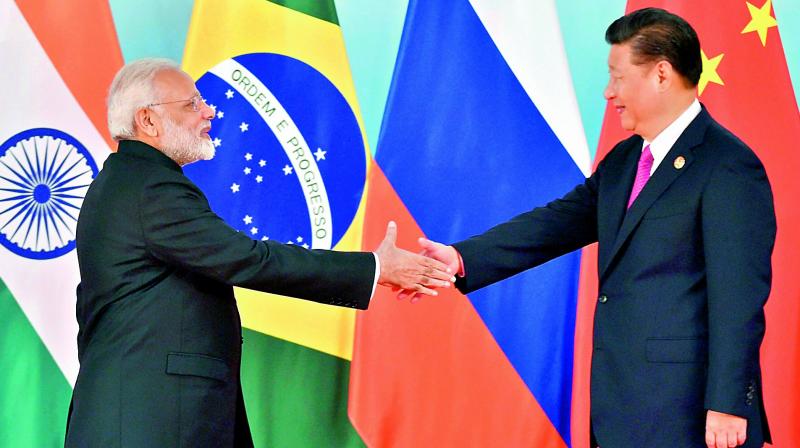Is Beijing rethinking its strategy on India?

The Xiamen Declaration issued at the end of the 9th Brics summit held in that city in China’s southeastern Fujian province earlier this week is a 70-odd-paragraph peroration entitled “Stronger Partnership for a Brighter Future” that captures the consensus among five major emerging economies of Asia, Africa and Latin America. Brazil, Russia and South Africa are oil and commodity exporters. With oil prices dropping precipitously since 2014 and the Chinese hunger for commodities abating sharply as their economy slowed, analysts started referring to loose “bricks” in Brics’ wall. President Donald Trump’s rise heralded precipitous change in America’s strategic posture, creating a strategic vacuum. It took the United States from undisputed global hegemony underwriting the existing economic, financial and political post-World War II geopolitical order to “America First”. Initially it appeared like an anti-globalisation and isolationist stance, abandoning allies in Europe and the Far East. Mr Trump’s subsequent actions only confused the picture as he approved a limited surge of troops in Afghanistan, declared a war till victory against terror groups threatening the US and the West, chastised Pakistan and locked horns with China over North Korea’s missile and now sixth nuclear test, simultaneously opening an inquiry into Chinese purloining of the intellectual property of US companies. The current Brics summit was held against this evolving background. In addition, for India, the negative trend lines of Sino-Indian relations raised questions about the utility of China-dominated groupings. After decades of clandestine propping up of Pakistan to stymie India, Chinese support became bolder. The China-Pakistan Economic Corridor (CPEC), involving investment of $46 billion, was finalised, ignoring likely Indian objections as it traversed Gilgit and Baltistan, claimed by India. Further, China tied it to its broader Belt and Road Initiative (BRI) — a modern resurrection of the old Silk Road with a maritime dimension.
India reacted by standing alone and boycotting the Beijing Forum, attended by most of India’s South Asian neighbours. Two additional provocations were already irritating India. China had been vetoing Indian membership of the Nuclear Suppliers Group (NSG), arguing that membership of non-signatories to the Nuclear Non-Proliferation Treaty needed to be settled first. India saw it as an attempt to obtain nuclear legitimacy for Pakistan, a recipient of Chinese nuclear technology and serial proliferator via the A.Q. Khan network. China had also been blocking the listing of terrorist and Jaish-e-Mohammad head Masood Azhar by the UN Security Council’s 1267 committee. India responded by boycotting the BRI Forum and critiquing it. India said sovereignty issues could not be ignored when China was over- sensitive to any breach of its perceived sovereignty. Further, financial viability of the projects was questionable. The inability of Sri Lanka to repay the Hambantota debt, leading to land being ceded on lease to China for a free zone, only confirmed Indian doubts. The Doklam stand-off brought the lingering tension to a head. Had India not gone to Bhutan’s aid, it would have allowed China to draw it into its sphere of influence by offering territorial concessions elsewhere, having gained an advantage in a region vital for India. The resolution of the imbroglio days before the Xiamen summit and the Chinese willingness to let Pakistan-based terrorist groups to be listed in the declaration raises the question of whether there is a strategic rethink by China on India?
The Xiamen Declaration has three subsections – Brics Practical Economic Cooperation; Global Economic Governance and International Peace and Security. There is least dissonance between the five on the second subject. All want a WTO-led open and inclusive trading system. All seek amending of IMF voting rights to reflect the current economic strength of members. Brics is also an important G-20 ginger group and could push its agenda through that forum. But this ignores Russia facing sanctions by the US and pilloried by Europe over Ukraine. India has played along, but is best served dealing with its friends in the West directly and eschewing the nonaligned-type trade unionism. The first issue is intra-Brics dealings which will be driven by China as the largest economy and trader. There are, however, limits due to the geographical spread of members, and failing governance in Brazil and South Africa. The Indian economy is also struggling after the twin shocks of demonetisation and GST. The Russian economy is still oil and gas dependent, besides diminished export of arms.
The latest US sanctions may make it difficult even for India to trade with Russia without breaching US laws. Information Communications Technology (ICT) figures prominently in the declaration. Against the background of the hacking charges against Russia and commercial and other Internet-based espionage by China, surely the Web is unlikely to be more neutral were autocratic regimes to get control over the servers. India has to be careful about the company it keeps as freedom of information is involved. The third segment relates to international peace and security. Apropos the listing of Pakistan-based terror groups, China makes strategic shifts gradually. It is possible that to get India on board the BRI and realising that the “far enemy” US is more challenging than the immediate “rival” India, it is possible that a genuine detente with India may be attempted. China can see growing convergence between the US, Japan and India economically, technologically and militarily. India too, having obtained their concession, concurred in the mild deploring of North Korea’s testing, in defiance of the global community, of a hydrogen bomb. But this would be noted in both Tokyo and Washington. Brics, Shanghai Cooperation Organisation, and the Russia-India-China forum called RIC are Chinese means to impose an order on the old global structures of governance. India requires a balancing game between the emerging and the old orders. The test for Indian diplomacy in the coming decades will be in its ability to bridge these two worlds without unconditionally espousing either.

